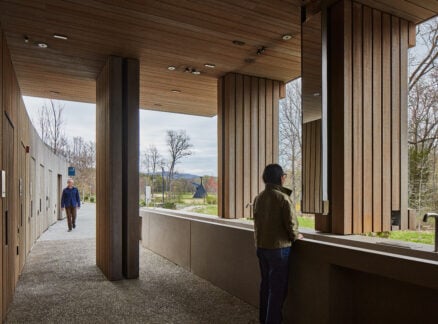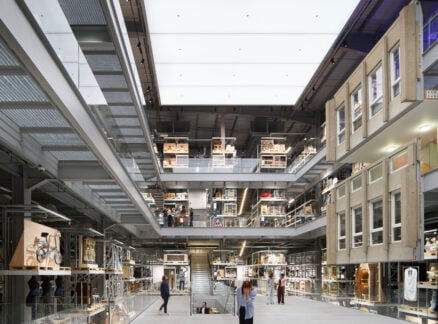June 13, 2007
Beyond the Garden
Landscape architect Cornelia Hahn Oberlander discusses her ahead-of-the-curve career in sustainability.
Based in Vancouver, Canada, the German-born, Harvard-educated Cornelia Hahn Oberlander developed her eco-conscious yet minimalist approach to landscape architecture—with a current focus on green roofs—way before Al Gore made it cool to care. Oberlander’s projects include a roof garden for Moshe Safdie’s Vancouver library, the city’s Robson Square development, and a collaboration with New York City-based landscape architect Hank White on the currently-under-construction new New York Times building. The 82-year-old Oberlander is the recipient of, among other accolades, the Order of Canada, and of the Royal Architectural Institute of Canada Allied Medal. She recently spoke to Eva Hagberg about the importance of landscape, the necessity for green, and the problem with city roofs today.
Tell me about your background. I read a quote that said you knew you wanted to be a landscape architect at 11 — how did you know that?
I became interested in the garden through my mother, who was a horticulturist. She wrote books for children on gardening. I sat in the studio of a very famous German artist who did the painting of me that depicted an imaginary town on the Rhine, with roads that met the river at right angles, with streets that had little brick houses, and with green spaces. I asked the artist “What’s the green space?” and the artist said, “These are parks.”
My mother said, “You have to drive a bulldozer if you want to be a landscape architect.” I grew up in a farm on New Hampshire—I came to America when I was sixteen—where there was, luckily, an old Ford tractor which I could drive without a license.
From there I went to Smith College and then to Harvard Graduate School of Design when the head of architecture was Walter Gropius and there I learned my fine profession. Dan Kiley and James Rose had been there before me and in 1938 had published a manifesto in Progressive Architecture not to do with our gardens—the gardens of the Beaux Arts—but modern gardens as they were discussed in Sweden.
I was very much influenced by the teaching at Harvard, especially basic design, which was taught by Josef Albers and others. And that made me learn about design, which you can apply to buildings as well as a landscape.
Who do you consider your mentors and how have they impacted your work?
The early mentors certainly were James Rose and Dan Kiley for whom I worked. I was definitely influenced by the modern design that was available to the public through Philip Johnson’s early exhibitions at MoMA. Of course the international style was taught at Harvard where we had collaborative problems to solve, between architects and planners, which is not always done. So I was educated to understand architecture as well as landscape architecture.
I think now there are schools of architecture and landscape architecture that are converging—The University of Oregon, in particular.
You’ve been in the business for a long time —almost 50 years—what kinds of changes have you seen in the world of landscape architecture? What kinds of changes are you anticipating in the future?
I gave a lecture at Smith in 2001 about landscape architecture breaking new ground. Why do we have to break new ground? Because over the last fifty years several landmark events occurred that affect our lives and the profession of landscape architecture in particular. Rachel Carson’s Silent Spring, Ian McHarg’s Design with Nature, the United Nations conferences on the environment and human settlement were some of the most important events that changed how we should work.
And only this past year, in November and December, did I have a feeling when I was in New York that people are catching on that we have to work differently. That is of course largely due to Al Gore’s The Inconvenient Truth, and by another film by Edward Burtynsky, a Canadian photographer, called Manufactured Landscapes.
Today, landscape architects and architects and engineers have a critical role to play in mitigating the impact of environmental degradation of our planet. I’ve told this to many people in many places and people still don’t believe it.
Why not?
People sit in front of their computers and they think the computer will get them all the answers without comprehending the depth of ecology or the power of observation of the land. And that has to do with their training going back into early childhood education. Can you tell me kids in New York know the trees in Central Park? And the trees aren’t labeled, so they just don’t see it. And the nannies sitting with them on 86th and 5th, they just worry that the kids don’t get too dirty in their little sandbox.
The good changes are due to LEED in the U.S. Green Building Council. They are pressing the landscape architects and the architects to build green. And that’s good, but there’s more to it.
Ecology is more than just another part of design. It must be viewed holistically, the genus loci, or spirit of the place. If we can accept this we will be successful as teams of landscape architects transmitting to the users new, aesthetic dimensions based on ecological design. Today, all my work is directed to storm water management, limiting footprints of buildings, and green roofs. And that’s how the profession has changed from garden-making. So if you do a garden now, you have to collect the rainwater for irrigation. If we do a private residence, we have to teach the people that own this piece of land that you have to have permeable pavement that allows the water to go down to the earth and not to the trench drain.
You’re very active in terms of environmental and community service – why is that so important to you?
Community service is very important because I design play areas or little parks and they’re all part of the community.
Where do you see landscape architecture’s role in terms of changing the way we live?
Land is scarce. People will have very small gardens, if at all, and so we have to use the ground that we’re taking for building and build usable space. There’s been a population explosion. In 1950 only thirty percent of our population lived in a city, but today it’s more than fifty—almost eighty percent, I believe. There are population pressures on the city, people want to live in the city, they no longer live in the country and that changes our work.
For example, for the New York Times building by Renzo Piano I teamed up with a landscape architect from named Hank White (of HM White Site Architects). There will be a courtyard, a minimalistic courtyard, and a roof garden on top. In order to be able to do this type of work in New York, it was necessary to have a micro-climatic study done, to show where the light was best, where the wind would not allow people to sit outside. This study has just won the merit award of the American Society of Landscape Architects.
What is your take on the interest in landscapes like green roofs?
I wrote an introductory manual to green roofing with Elisabeth Whitelaw and Eva Matsuzaki. Why am I interested in green roofs? First of all it’s the island effect, slowing down water, and making it aesthetically pleasing to look at. Are you looking at a gravel roof from your office?
I’m looking at a tar one.
Yes, it’s a sea! If you would make those green, you would increase the biomass, you would increase the pleasure of people by giving them something green to look at.





